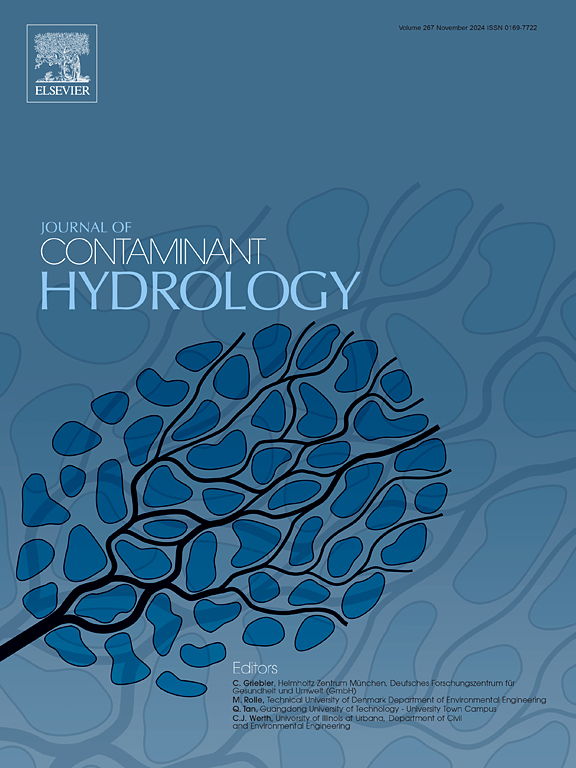吸附-解吸过程有助于三氯乙烯在多孔介质中的自然衰减
IF 4.4
3区 环境科学与生态学
Q2 ENVIRONMENTAL SCIENCES
引用次数: 0
摘要
监测自然衰减(MNA)是一种依靠自然过程随时间降低污染物浓度的方法,被广泛用于管理稀释氯化溶剂地下水羽流。在非均质含水层中,氯化溶剂的积累和随后的释放会强烈影响MNA的长期有效性。研究了限制速率的吸附-解吸过程对低渗透介质中三氯乙烯(TCE)释放的影响。在4种天然土壤中进行了间歇反应器研究,以建立平衡线性分布系数(KD),其范围为0.4 ~ 1.0 mL/g。柱输送研究随后完成,使用相同的土壤在两种流速下,流动中断的时期,以评估速率限制解吸。采用了一个包含“两点”吸附模型的数值模拟器来拟合出水浓度数据,并获得了瞬时平衡吸附位点的分数(f)和时间相关位点的吸附速率(k)的参数,其范围分别为0.2至0.6和0.3至3天。随后的模型模拟用于说明这些吸附参数对低渗透多孔介质中TCE的扩展释放的重要性。这些发现表明,在评估MNA作为氯化溶剂羽流的长期补救措施时,除了反向扩散外,还应考虑速率限制的吸附-解吸过程。本文章由计算机程序翻译,如有差异,请以英文原文为准。
Sorption-desorption processes contributing to natural attenuation of trichloroethene in porous media
Monitored natural attenuation (MNA), which relies on natural processes to reduce contaminant concentrations over time, is widely used to manage dilute chlorinated solvent groundwater plumes. In heterogeneous aquifers, the accumulation and subsequent release of chlorinated solvents can strongly influence the long-term effectiveness of MNA. This research investigated rate-limited sorption-desorption processes influencing trichloroethene (TCE) release from lower-permeability media. Batch reactor studies were conducted with four natural soils to establish equilibrium linear distribution coefficients (KD), which ranged from 0.4 to 1.0 mL/g. Column transport studies were then completed using the same soils at two flow rates, with periods of flow interruption, to assess rate-limited desorption. A numerical simulator that incorporates a “two-site” sorption model was used to fit the effluent concentration data and obtain parameters for fraction of sorption sites at instantaneous equilibrium (f) and the rate of sorption for time-dependent sites (k), which ranged from 0.2 to 0.6 and 0.3 day−1 to 3 day−1, respectively. Subsequent model simulations were used to illustrate the importance of these sorption parameters on the extended release of TCE from low permeability porous media. These finding demonstrate that in addition to back diffusion, rate-limited sorption-desorption processes should be considered when evaluating MNA as long-term remedies for chlorinated solvent plumes.
求助全文
通过发布文献求助,成功后即可免费获取论文全文。
去求助
来源期刊

Journal of contaminant hydrology
环境科学-地球科学综合
CiteScore
6.80
自引率
2.80%
发文量
129
审稿时长
68 days
期刊介绍:
The Journal of Contaminant Hydrology is an international journal publishing scientific articles pertaining to the contamination of subsurface water resources. Emphasis is placed on investigations of the physical, chemical, and biological processes influencing the behavior and fate of organic and inorganic contaminants in the unsaturated (vadose) and saturated (groundwater) zones, as well as at groundwater-surface water interfaces. The ecological impacts of contaminants transported both from and to aquifers are of interest. Articles on contamination of surface water only, without a link to groundwater, are out of the scope. Broad latitude is allowed in identifying contaminants of interest, and include legacy and emerging pollutants, nutrients, nanoparticles, pathogenic microorganisms (e.g., bacteria, viruses, protozoa), microplastics, and various constituents associated with energy production (e.g., methane, carbon dioxide, hydrogen sulfide).
The journal''s scope embraces a wide range of topics including: experimental investigations of contaminant sorption, diffusion, transformation, volatilization and transport in the surface and subsurface; characterization of soil and aquifer properties only as they influence contaminant behavior; development and testing of mathematical models of contaminant behaviour; innovative techniques for restoration of contaminated sites; development of new tools or techniques for monitoring the extent of soil and groundwater contamination; transformation of contaminants in the hyporheic zone; effects of contaminants traversing the hyporheic zone on surface water and groundwater ecosystems; subsurface carbon sequestration and/or turnover; and migration of fluids associated with energy production into groundwater.
 求助内容:
求助内容: 应助结果提醒方式:
应助结果提醒方式:


